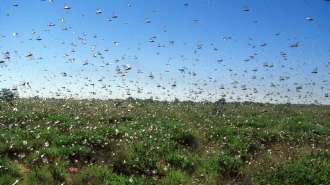Search Results
Lightning lab
Lightning is a familiar natural phenomenon, but what causes it? In this activity, students will do a short electrostatics lab with sticky tape. They will also compare what happens in regular lightning with what happens in a megaflash.
Astronauts Need Oxygen
Students will consider how atoms and molecules interact with one another. Then they’ll analyze the effects of different types of energy on chemical reactions and how forces impact the motion of gas bubbles in a solution. Students will work in pairs to formalize their thinking using models to understand matter, energy and forces during chemical reactions.
Frilly-Footed Water Walkers
Nature solved a great design ‘feet’ — and engineers are now taking notice. Inspired by water-striding insects, they’ve invented a fancy-footed, water-walking robot. Learn how researchers might look to nature for inspiration in design and invention. Answer questions about the value of analogies in explaining unfamiliar concepts, then discuss possible applications for fancy-footed robots.
The Pickleball Pickle
Students will learn the differences between qualitative and quantitative research methods by observing how covering the holes on a pickleball affects the ball’s drag and motion through the air. Students will leave this activity with an understanding that qualitative and quantitative research methods are both valid forms of research and that personal experiences and qualitative research often precede quantitative research methods.
Hula-hooping robots
Scientists built hula-hooping robots to answer an old mystery: How does a Hula Hoop stay up? Learn how best to launch and maintain a circulating hoop — and then explore how specific shapes can turn gyrations into a gravity-defying force. You can apply those concepts to then predict the hula-hooping success of other shapes.
An eyelash of elegant design
Raindrops might fall on your head, but thanks to your eyelashes, they rarely drip into your eyes. Learn how the simple, elegant design of our eyelashes flicks away water. Answer questions about diverse functions of body hair, all while discussing the value of analogies as a literary device used to improve understanding of unfamiliar concepts.
Where force fields collide
Scientists have long suspected that a mysterious third force underlies the unique life-sustaining conditions of our planet but lacked the technology to measure it. Until now, that is. Learn how the interplay between different planet-wide energy forces gives rise to Earth’s cozy atmosphere. Then, explore how scientists use modern technology to study a newly discovered electrical field and fit this knowledge into their global understanding of how our planet supports life.
Egyptian hydraulics: Does this idea hold water?
How did the ancient Egyptians build the pyramids? It's an age-old mystery. A new study points to hydraulic engineering. But does this idea really hold water? Some experts in the field argue against new evidence being provided to support such claims. Learn how researchers use evidence to support claims while discussing the value of healthy skepticism in science.
A sweaty plant adaptation
Sweating has a surprising purpose for one desert plant. Students will learn about a chemical adaptation that allows the plant to collect moisture in an arid environment. They’ll answer questions about using videos to collect data and then draw molecular diagrams that illustrate the plant’s adaptation.
Applying the ideal gas law
Summary: Students will review the ideal gas law and use a simulation to explain the assumptions made in a recent study about how climate change is impacting baseball.
Learning Outcomes: Exploration of the cause and effect of manipulating conditions of a gas using a simulation, identifying relationships of variables using a mathematical equation and application of theoretical concepts to real-world examples.
Defining and defying Roche limits
Students will review force diagrams and gravitational force and discuss planetary ring and moon formation using the concept of the Roche limit.
Learning Outcomes: Applying gravitational forces and interactions in space to understand ring and moon formation.

Insect Swarms Might Electrify the Sky
Large swarms of insects could produce as much electricity as a storm cloud. In this guide, students will explore how insect-induced static electricity might affect the atmosphere, review the concepts of electric charge and electrostatic force, and apply those concepts to their own experiences and the biological phenomenon of insect swarms. In a quick activity, students will create a poem or song about serendipity in science.